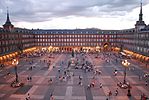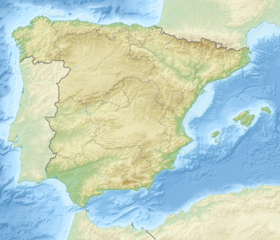Madrid
Madrid (pronounced: “mah-drid or /məˈdrɪd/) is the capital and largest city of Spain. Madrid is in the middle of Spain, in the Community of Madrid. The Community is a large area that includes the city as well as small towns and villages outside the city. 7 million people live in the Community. More than 3 million live in the city itself. It is the largest city of Spain and, at 655 m (2,100 ft) above sea level, the second highest capital in Europe (after the Andorran capital Andorra la Vella). It is the second largest city in the European Union. As it is the capital city, Madrid is where the monarch lives and also where the government meets. Madrid is the financial centre of Spain. Many large businesses have their main offices there. It has four important footballs teams, Real Madrid, Atlético Madrid, Getafe, and Rayo Vallecano. People who live in Madrid are called madrileños.
Madrid | |
|---|---|
From upper left: Gran Vía, Plaza Mayor, business districts of AZCA and CTBA, Puerta de Alcalá and the Royal Palace, Almudena Cathedral | |
| Motto(s): "Fui sobre agua edificada, mis muros de fuego son. Esta es mi insignia y blasón" ("On water I was built, my walls are made of fire. This is my ensign and escutcheon") | |
| Coordinates: 40°25′N 3°43′W / 40.417°N 3.717°W | |
| Country | |
| Autonomous community | Community of Madrid |
| Founded | 9th century[1] |
| Government | |
| • Type | ayuntamiento |
| • Body | Ayuntamiento de Madrid |
| • Mayor | José Luis Martínez-Almeida (PP) |
| Area | |
| • capital city and municipality | 604.31 km2 (233.33 sq mi) |
| Elevation | 820 m (2,690 ft) |
| Population (2018)[4] | |
| • capital city and municipality | 3,223,334 |
| • Rank | 1st (2nd in EU) |
| • Density | 5,300/km2 (14,000/sq mi) |
| • Urban | 6,345,000 (2019)[3] |
| • Metro | 6,791,667 (2018)[2] |
| Demonym(s) | Madrilenian, Madrilene madrileño, -ña; matritense gato, -a |
| Time zone | UTC+1 (CET) |
| • Summer (DST) | UTC+2 (CEST) |
| Postal code | 28001–28080 |
| Area code | +34 (ES) + 91 (M) |
| HDI (2018) | 0.928[5] – very high |
| Website | madrid |

Madrid was ruled by the Romans from the 2nd century. After AD 711 it was occupied by the Moors. In 1083 Spain was ruled again by Spaniards. Catholic kings ruled the country. By the mid-16th century it had become the capital of a very large empire. Spain was ruled by monarchs from the House of Habsburg, then the House of Bourbon. After the Spanish Civil War it was ruled by a dictator until the mid-1970s when it became a democracy.
Although it is a modern city, a lot of its history can be seen and felt as one walks along the streets and in the large squares of the city. There are beautiful parks, famous buildings, art galleries and concert halls.
History
changeDuring the history of Spain many different people have lived there. Madrid's name comes from the Arabic word magerit, meaning “place of many streams".[6] The Phoenicians came in 1100 BC, followed by Carthaginians, Romans, Vandals, Visigoths and Moors. It was not until 1492, when the Catholic Monarchs got power, that Spain became a united country. Jews and Moors, who had lived happily there for many years, were driven away. Spain became very rich because it conquered many overseas countries, especially in Central and South America. However, Spain fought many wars and lost much of its treasure. It was very poor in 1936 when the Civil War was fought. General Franco became a harsh dictator until 1975 when Juan Carlos I was brought back to Spain and made king. There is now a democratic government.
In prehistoric times people lived in the area which is now Madrid. The Romans lived there for several centuries. The origin of today’s city really starts in the 9th century when Muhammad I had a small palace built where the Palacio Real stands today. The Moors built strong forts in Madrid in 865 and put a wall round the city. These walls stood until 1476 when they were knocked down. In 1561 Felipe I moved the royal court from Toledo to Madrid. Madrid had now become the capital of a very large empire. Over the next years and decades the Plaza Mayor was built and many great buildings and monuments, many of which still stand.
When Ferdinand II of Aragon and Queen Isabella of Castile came to Madrid, Spain had become a very rich country. The 16th and 17th centuries are now known as the “Golden Century”. Their grandson was the famous Charles I of Spain (also known as Charles V, Holy Roman Emperor). He liked his court to be in Seville. His son, Philip II (1527–1598) moved the court to Madrid in 1561.
In the late 1800s there was a revolt, known as the First Spanish Republic. Later the monarchy was restored, but then there was a Second Spanish Republic followed by the Spanish Civil War. The Second Spanish Republic started on 14 April 1931 and was celebrated in La puerta del Sol which is the center of the city. Madrid suffered a lot in this war. It was bombed by airplanes.
During the dictatorship of Francisco Franco, especially during the 1960s, south Madrid became very industrialized, and many people from the rural areas moved to Madrid especially to the south east of the city.
When General Franco died and democracy was restored, Madrid became more prosperous. During the 1980s and 1990s many new buildings were put up.
Madrid has been attacked many times by terrorists. This includes the bombing of a restaurant in 1985, killing 18 people and the of trains in 2004, killing over 190 people.
Geography
changeMadrid has a borderline cold semi-arid climate (BSk in the Köppen climate classification) and a hot-summer Mediterranean climate (Csa in the Köppen climate classification). Most rain falls in autumn and spring. The winters are cool because it is high up, and occasionally it snows. The summers are hot and dry. Often the temperature is above 30 °C (86 °F) in July and August and can often reach 40 °C (104 °F). At night it is much cooler. This is why many offices and businesses are closed and people have a sleep (siesta) in the afternoon when it is hot. Then they come out again in late afternoon and often eat dinner late at night.
Buildings in Madrid
changeSpain's Royal Palace is in Madrid. It is one of the largest palaces in all of Western Europe. But the king and his family do not live there anymore; they live in a smaller palace, and only use the Royal Palace for important events, like meeting other kings and other official ceremonies. One can go inside the Royal Palace and learn about the history of Spanish monarchy.
Other famous buildings are: The Prado Museum, the Temple of Debod, the Santiago Bernabeú Stadium and the Cuatro Torres Business Area.
Art galleries
changeThere are a lot of very big and important art museums in Madrid. The most famous ones are the Prado Museum, the Queen Sofia Museum, and the Thyssen-Bornemisza museum. These show off paintings, sculptures, and other works of art from some of the most famous artists in the world.
Many famous, important, and valuable works of art are in these museums. For example, the Queen Sofia museum has a famous painting by Pablo Picasso, called Guernica. Picasso painted this painting to show how sad and angry it made him when the German Nazis destroyed a town in Spain called Guernica in 1937. Picasso had said that the painting should never return to Spain until it was a democracy again. Once that happened, they built the Queen Sofia museum just to have a good place to put it.
Other sights
changeThere are many other sights to see in Madrid. Many people go to see the Plaza Mayor which was a market place. The Plaza de la Villa was another famous market place. There are a lot of shops along the Gran Via. Real Madrid football fans celebrate at the Plaza de Cibeles. Two famous gates to see are the Puerta del Sol and the Puerta de Alcalá. A more recent landmark is the Almudena Cathedral.
Madrid has some lovely parks. The Retiro Park is the most famous. The Cristal Palace can be found in this park.
The Plaza de Toros is visited by many tourists. Bullfights take place there.
References
change- ↑ "History of Madrid". Madrid Traveller. Archived from the original on 29 August 2014. Retrieved 27 August 2014.
- ↑ "Population on 1 January by age groups and sex - functional urban areas". Eurostat. Archived from the original on 2015-09-03. Retrieved 2021-01-27.
- ↑ "Demographia World Urban Areas" (PDF). Demographia. 2019. Archived (PDF) from the original on 2020-02-07. Retrieved 2013-10-17.
- ↑ Municipal Register of Spain 2018. National Statistics Institute.
- ↑ "Sub-national HDI - Area Database - Global Data Lab". hdi.globaldatalab.org. Archived from the original on 2018-09-23. Retrieved 2021-01-27.
- ↑ "Spain: An Unforseen Marvel". Retrieved 29 July 2024.








